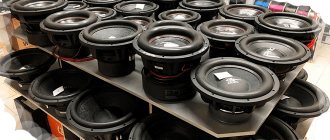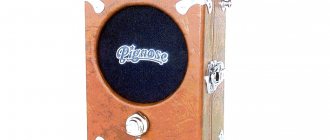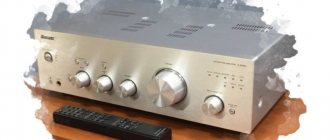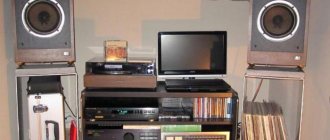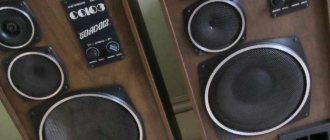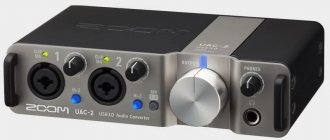Nikolay Troshin
Recently, there has been a noticeable increase in interest in power amplifiers based on germanium transistors. There is an opinion that the sound of such amplifiers is softer, reminiscent of “tube sound”. I bring to your attention two simple circuits of low-frequency power amplifiers using germanium transistors, which I tested some time ago.
More modern circuit solutions are used here than those used in the 70s, when “germanium” was in use. This made it possible to obtain decent power with good sound quality. The circuit in the figure below is a reworked version of the low-frequency amplifier for “germanium” from my article in Radio magazine No. 8, 1989 (pp. 51-55).
The output power of this amplifier is 30 W with a speaker load impedance of 4 ohms, and approximately 18 W with a load impedance of 8 ohms. The amplifier supply voltage (U supply) is bipolar ±25 V; Operating frequency range 20Hz…20kHz:
Origin of the element
Germanium was discovered by Clemens and Winkler in the German city of Freiberg in 1886. The existence of this element was predicted by Mendeleev, having previously established its atomic weight as 71 and density as 5.5 g/cm3.
In the early autumn of 1885, a miner working at the Himmelsfürst silver mine near Freiberg came across an unusual ore. It was given to Albin Weisbach from the nearby Mining Academy, who confirmed that it was a new mineral. He, in turn, asked his colleague Winkler to analyze the production. Winkler discovered that the composition of the found chemical element contained 75% silver, 18% sulfur; the scientist could not determine the composition of the remaining 7% volume of the find.
By February 1886, he realized that this was a new metal-like element. When its properties were tested, it became clear that it is the missing element in the periodic table, which is located below silicon. The mineral from which it came is known as argyrodite - Ag 8 GeS 6. Several decades later, this element will serve as the basis for germanium transistors for sound.
Germanium
At the end of the 19th century, germanium was first isolated and identified by the German chemist Clemens Winkler. This material, named after Winkler's homeland, has long been considered a low-conductivity metal. This statement was revised during the Second World War, since it was then that the semiconducting properties of germanium were discovered. Devices consisting of germanium became widespread in the post-war years. At this time, it was necessary to satisfy the need for the production of germanium transistors and similar devices. Thus, germanium production in the United States increased from several hundred kilograms in 1946 to 45 tons by 1960.
Chronicle
The history of the creation of transistors begins in 1947 with Bell Laboratories, located in New Jersey. Three brilliant American physicists were involved in the process: John Bardeen (1908–1991), Walter Brattain (1902–1987), and William Shockley (1910–1989).
The team led by Shockley was trying to develop a new type of amplifier for the US telephone system, but what they actually invented was much more interesting.
Bardeen and Brattain built the first transistor on Tuesday, December 16, 1947. It is known as a point contact transistor. Shockley worked hard on the project, so it's not surprising that he was emotional and angry that it was rejected. Soon he single-handedly formed the theory of the junction transistor. This device is superior to a point contact transistor in many ways.
The birth of a new world
While Bardeen left Bell Labs to become an academic (he went on to study germanium transistors and superconductors at the University of Illinois), Brattain worked for a while and then went into teaching. Shockley founded his own transistor company and created a unique place - Silicon Valley. This is a prosperous area in California around Palo Alto, home to large electronics corporations. Two of his employees, Robert Noyce and Gordon Moore, founded Intel, the world's largest chip manufacturer.
Bardeen, Brattain and Shockley were briefly reunited in 1956 when they received the world's highest scientific award for their discovery, the Nobel Prize in Physics.
In simple words
The principle of operation of a transistor-based sound amplifier will become clearer if we draw an analogy with the principle of operation of a water tap: the emitter is a pipeline, and the collector is a tap. This comparison helps explain how a transistor works.
Let's imagine that the transistor is a water tap. Electric current acts like water. The transistor has three contacts: base, collector and emitter. The base acts as a faucet handle, the collector acts as water flowing into the faucet, and the emitter acts as a hole from which water flows out. By turning the faucet handle slightly, you can restrain the powerful flow of water. If you turn the faucet handle slightly, the flow rate of water will increase significantly. If you close the faucet handle completely, no water will flow. If you turn the handle all the way, the water will flow much faster.
↑ Version 1.1 or “God grant you what is not good for us”
And the amp returned to me again.
I began to think about what to do with it. Don't throw it away? Then I decided to use it for guitar purposes. It was the younger generation of relatives who became infected with this matter. And they had the instrument, they just connected it, like in the good old days, whatever it took. So I decided to redo it a little and give it away. At least some benefit. In principle, two honest Soviet watts (one and a half at a load of 8 ohms), fed to no less honest, not even necessarily Soviet, acoustics - the power is quite sufficient to play along with an acoustic guitar in an ordinary, not very large room, with sufficient volume and not clog " vocalist" if there is one. And taking into account the soundproofing of our apartments and neighbors, we can have a lot of fun.
The typical frequency range of most tape recorder amplifiers is even somewhat wider than what is needed for a guitar. But at that time I was not yet familiar with the opinion of the “experts” regarding its additional artificial narrowing (where did they come from in our wilderness, then still without the Internet?) Moreover, the device was not intended for concerts with orchestras and recordings in studios. And certainly not to compare with the company.
Operating principle
As mentioned earlier, germanium transistors are circuits that are based on three contacts: emitter (E), collector (C) and base (B). The base controls the current from the collector to the emitter. The current that flows from the collector to the emitter is proportional to the base current. The emitter current, or base current, is equal to hFE. This setup uses a collector resistor (RI). If a current Ic flows through RI, a voltage will be generated across this resistor that is equal to the product Ic x RI. This means that the voltage across the transistor is: E2 - (RI x Ic). Ic is approximately equal to Ie, so if IE = hFE x IB, then Ic is also equal to hFE x IB. Therefore, after the replacement, the voltage across the transistors (E) is E2 (RI x le x hFE).
Functions
A transistor sound amplifier is built on the functions of amplification and switching. Using radio as an example, the signals that radio receives from the atmosphere are extremely weak. The radio amplifies these signals through the speaker output. This is the "boost" function. For example, the germanium transistor GT806 is intended for use in pulse devices, converters and current and voltage stabilizers.
For analog radio, simply amplifying the signal will cause the speakers to produce sound. However, for digital devices, the input waveform must be changed. For a digital device such as a computer or MP3 player, a transistor must switch the signal state to 0 or 1. This is the "switching function"
You can find more complex components called transistors. We are talking about integrated circuits made from liquid silicon infiltration.
↑ Interesting experiments on the final version
In view of the appearance of an oscilloscope (the “Visual Analyzer” program) on the farm, I could not resist observing the signal shape at the output of the already assembled amplifier.
Sine wave from the generator built into the “analyzer”. Signal at the generator output (linear output of an external sound card):
Signal at the PA load (Uout close to maximum):
Basically nothing unpredictable. I did not expect superior performance from this product. There is no noticeable distortion of the shape - and that’s good. Unless you can still “conjure” with the power supply.
For checks during the work, a home-made generator, hastily soldered, was used. He gave a slightly more optimistic picture:
Unlike the pictures above, the built-in sound card was used here. The higher noise level is immediately noticeable. And conclusions regarding its use suggest themselves. True, this is not relevant to the topic of the article.
And this is what a rectangular signal looks like, or rather the signal from the output of the “Faemi” tool described in my recent article.
An external sound card was used for testing. I won’t show you what the built-in one does with the signal so as not to scare anyone. Nothing unexpected either. Trimming along the “bottoms” and “tops”. To complete the picture, it would be possible to remove the frequency response, but why? The amplifier was not made for high-fi, but for a guitar.
Soviet "silicon valley"
In Soviet times, in the early 60s, the city of Zelenograd became a springboard for the organization of the Microelectronics Center there. Soviet engineer F. A. Shchigol develops the 2T312 transistor and its analogue 2T319, which later became the main component of hybrid circuits. It was this man who laid the foundation for the production of germanium transistors in the USSR.
In 1964, on the basis of the Research Institute of Precision Technologies, he created the first integrated circuit IC-Path with 20 elements on a chip, performing the task of a set of transistors with resistive connections. At the same time, another technology appeared: the first planar transistors “Plane” were launched.
In 1966, the first experimental station for the production of flat-plate integrated circuits began operating at the Pulsar Research Institute. At NIIME, Dr. Valiev's group began producing linear resistors with logic integrated circuits.
In 1968, Pulsar Research Institute produced the first part of thin film hybrid ICs with open frame planar transistors, types KD910, KD911, KT318, which are intended for communications, television, radio broadcasting.
Linear transistors with digital ICs for mass use (type 155) were developed at the ME Research Institute. In 1969, Soviet physicist Zh. I. Alferov revealed to the world a theory for controlling electronic and light flows in heterostructures based on the gallium arsenide system.
↑ PS
I recently went on business to the “land of our ancestors.” In my spare time, I pulled out of the barn the miraculously preserved tube amplifier mentioned at the beginning of the article - UMZCH and PSU from the "garbage" wreckage of the radio, inserted into a self-made "collective farm"-looking case.
I shook off the dust, cleaned everything I could, and connected the 10MAS-1 speaker, which is only a year younger than me. He plugged in the guitar, strummed a little on a clear sound, then buzzed through the lotion. And I caught myself thinking that if I reworked the power distribution and shielding, eliminated the “earth loops” that I simply couldn’t help but weave in those days, went through the tone block, which regulates something known only to designers, but not HF and LF, and even build in a preamp... Eh!
But that will be a different story. Or it won’t happen, it’s better not to guess.
Thank you for your attention!
Past vs Future
The first mass-produced transistors were based on germanium. P-type and N-type germanium were connected together to form a junction transistor.
The American company Fairchild Semiconductor invented the planar process in the 1960s. Here, silicon and photolithography were used to produce transistors with improved reproducibility characteristics on an industrial scale. This led to the idea of integrated circuits.
The significant differences between germanium and silicon transistors are as follows:
- silicon transistors are much cheaper;
- a silicon transistor has a threshold voltage of 0.7 V, while germanium has a threshold voltage of 0.3 V;
- silicon withstands temperatures of about 200 ° C, germanium - 85 ° C;
- Silicon leakage current is measured in nA, for germanium - in mA;
- The PIV of Si is higher compared to Ge;
- Ge can detect small changes in signals, hence they are the most "musical" transistors due to their high sensitivity.
↑ And now silicon sings!
Now let's analyze the circuit (Fig. 7), consisting of a voltage amplifier according to a circuit with a common emitter on transistor VT1 and a current amplifier on complementary composite emitter followers VT2, VT3.
↑ Amplifier circuit of a similar structure, but on silicon
Fragment excluded. The full version is available to patrons and full members of the community.
Rice. 7. Schematic diagram of a simple UMZCH on silicon transistors
The input signal is supplied to the base of transistor VT1 through decoupling capacitor C1, ferrite bead L1 and resistor R1.
The transmission coefficient of an amplifier covered by negative feedback (NFB) is determined by the divider R1, R7, R9, R10:
Ku= – [(R7+R10)||R9]/R1=– 11.5 (21.2 dB).
The constant resistor R7 and the tuning resistor R10 determine the DC operating mode of the circuit (voltage at the midpoint), and the resistor R9 is placed behind the transition capacitor C5, which linearizes its characteristic. As a result, the right (according to the circuit diagram in Fig. 7) terminal of resistor R9 is connected directly to the speaker system.
To ensure that when the loudspeaker is disconnected, the DC operating mode of the circuit does not change, resistor R13 is introduced. It performs another function in the circuit - it prevents clicks when connecting the speaker system. The output coupling capacitor results in a reduction in output power at low frequencies, as well as a deterioration in the damping factor.
With the capacitance of the coupling capacitor C6=4700 μF, load resistance Rн=4 (8) Ohm and lower frequency fн=20 Hz, the output power will decrease by {Rн/SQRT[(Rн^2+(Sπ fнС5)^2]}^2 times At a frequency of 20 Hz at Rн=4 Ohm, the output power will decrease by 15%, and at Rн=8 Ohm - by 4%.
Increasing the damping factor and output power at low frequencies is achieved using an additional feedback circuit through resistor R9.
The choice of sufficiently low resistance resistor values contributes to the stability of the OOS circuit throughout the entire audio range.
Resistors R6, R8 in the Darlington base circuits VT2, VT3 serve to prevent self-excitation of the emitter followers at high frequencies.
Elements R3, R4 and C4 form a “voltage boost” circuit, a PIC circuit to provide the required base current VT2 and VT3 at signal peaks and improve the quality of the negative half-wave of the output voltage.
The depth of the PIC through capacitor C4 is determined by the ratio of R4 to R3, as well as by the resistance value of resistors R11, R12 in the emitter circuits of transistors VT2, VT3.
Elements R2, VD1 – VD3 serve to provide initial bias in the base circuits of repeaters VT2, VT3. To ensure the temperature stability of the amplifier, good thermal contact of the diodes VD1 - VD3 with the radiators of the output transistors VT2, VT3 is necessary.
Using trimmer resistor R2, the quiescent current of the output stage is set in the range of 40 - 70 mA, the recommended value is 60 mA. It is set by the voltage drop across resistors R11, R12 (12 mV).
↑ Silicon amplifier details
Transistor VT1 type 2N5551 can be replaced with MPSA42, MPSA43.
It is advisable to select transistors with a transmission coefficient h21e=150...250. Complementary transistors 2SD2390/2SB1560 (Uke=150 V, Pk=100 W, Ik=10 A, fT=55 MHz, h21e=5000) in the TO-3R package, can be replaced with 2SD2438/2SB1587, 2SD2439/2SB1588 in the same case, as well as on 2SD2589/2SB1659 in the MT-200 case.
Power transistors VT2, VT3 are installed through heat-conducting substrates on a common radiator with a cooling surface area of at least 300 square meters. cm.
Capacitor C3 is ceramic for an operating voltage of at least 50 V; High voltage ceramics are acceptable. Inductance L1 in the form of a ferrite bead is soldered from faulty computer sound cards.
Many parts for this design can be ordered from the Datagorsk online store “Radio Components - By Mail!”
↑ Details of the amplifier for two channels
VT1 – Transistor 2N5551 – 2 pcs., VT2 – Transistor 2SD2390 – 2 pcs., VT3 – Transistor 2SB1560 – 2 pcs., VD1…VD3 – Diode 1N4148 – 6 pcs., R1 – Res. 0.25 -510 Ohm (blue , red, brown, golden) – 2 pcs., R2 – Res.adjustment.
300 Ohm Trim 3296W-1-301 – 2 pcs., R3 – Res.-0.25-200 Ohm (red, black, brown, gold) – 2 pcs., R4 – Res.-0.25-1.8 kOhm (brown, gray, red, golden) – 2 pcs., R5 – Res.-0.25-150 Ohm (brown, green, brown, golden) – 2 pcs., R6, R8 – Res.-0.25 -68 Ohm (blue, gray, black, gold) – 4 pcs., R7 – Res.-0.25-33 kOhm (orange, orange, orange, gold) – 2 pcs., R9 – Res.-0.25 -9.1 kOhm (white, brown, red, gold) – 2 pcs., R10 – Res. trim. 33 kOhm Trim 3296W-1-333 – 2 pcs., R11, R12 — Res.-5-0.1 Ohm SQP – 4 pcs., R13 – Res.-1-470 Ohm (yellow, purple, brown, gold) – 2 pcs., R14 – Res.-0.5-20 Ohm (red, black, black, gold) – 2 pcs., C1 – Cond. 220/25V 0812 +105°C– 2 pcs., C2 – Cond. 470/16V 1013 +105°С – 2 pcs., C3 – Cond. NPO 33 pF 5% ceramic. imp. – 2 pcs., C4 – Cond. 100/63V 1013 +105°C – 2 pcs., C5 – Cond. 4700/50V 2235+105°С – 2 pcs., C6 – Cond. 1/63V K73-17 – 2 pcs., C7 – Cond. 470/63V 1321 105°C – 2 pcs., C8 – Cond. 0.047/630V K73-17 – 2 pcs., C9 – Cond. 0.68/63V K73-17 – 2 pcs., L1 – Inductance Ferrite beads – 2 pcs., X1, X2 – Terminal block 2K pitch 5 mm on TV-01A board – 2 pcs., X3…X6 – Knife terminal on the board TA-M/DJ610-6.3 – 8 pcs., 2A2318 – Heat-conducting substrate for TO-218, TO-247, with hole. – 4 pcs., Printed circuit board 70x85 mm – 2 pcs. The details of each UMZCH channel are located on a separate printed circuit board, Fig. 8.
Rice. 8. Placement of parts of one UMZCH channel
The appearance of the assembled printed circuit board of one UMZCH channel is shown in the abstract of the article.
The UMZCH connection in the device is made with a wire with a cross-section of 0.75 - 1 sq. mm. The mating part for the wires are 6.3 mm knife terminals (preferably insulated), designed for the specified wire cross-section. Crimping of knife terminals is performed with a special tool (Fig. 9). Pliers or a hammer will not provide the quality of connection achieved with special tools.
Rice. 9. Pliers for crimping terminals and contacts onto wires
↑ Setting up the amplifier
begin after carefully checking the correct installation.
Particular attention is paid to the correct installation of transistors, oxide capacitors and diodes, as well as the quality of soldering. To simplify setup, the slider of the trimming resistor R2 is set to the minimum resistance position, and the slider of the resistor R10 is set to half the nominal value. When turned on for the first time, the input jacks X1, X2 must be short-circuited and an equivalent load must be connected to the output. Operating modes should not differ from those indicated on the circuit diagram by more than 10%.
After a twenty-minute warm-up, resistor R10 sets the voltage at the symmetry point equal to half the supply voltage, and resistor R2 sets the output stage current to 60 mA, based on the voltage drop across resistors R11, R12 equal to 12 mV.
↑ Characteristics of its silicon counterpart
If instrumentation is available, the characteristics of the UMZCH are taken.
Characteristics of a simple UMZCH:
Supply voltage: 30 V; Maximum power with a load resistance of 4 Ohms: 20 W; Current consumption at maximum power, no more than: 1.0 A; Frequency range: 20 Hz…20 kHz (–0.5 dB); Harmonic distortion at 18 W output power: 0.03%; Voltage gain: 11.5 (21.2 dB); Sensitivity: 775 mV; Output resistance, no more than: 0.025 Ohm.
When connecting the amplifier to the sound reproduction path, it should be taken into account that it is inverting. It is necessary to take measures so that the path as a whole maintains the phase of the signal, i.e. was non-inverting. For example, take this fact into account by changing the polarity of connecting the speaker wires. However, the DACs of some players (for example, Pioneer BDP-170) invert the phase of the input signal, which, however, is not reflected in any way in the user manual.
Audio
To get high-quality sound on analog audio equipment, you need to decide. What to choose: modern integrated circuits (ICs) or ULF on germanium transistors?
In the early days of transistors, scientists and engineers argued over the material that would underlie the devices. Among the elements of the periodic table, some are conductors, others are insulators. But some elements have an interesting property that allows them to be called semiconductors. Silicon is a semiconductor and is used in almost all transistors and integrated circuits made today.
But before silicon was used as a suitable transistor material, it was replaced by germanium. The advantage of silicon over germanium was due mainly to the higher gain that could be achieved.
Although germanium transistors from different manufacturers often have different characteristics, certain types are said to produce warm, rich, and dynamic sound. The sounds can range from crunchy and jagged to muffled and smooth, with everything in between. Undoubtedly, such a transistor deserves further study as an amplification device.
↑ Version 1.2 or “I wanted the best...”
Time has passed.
Even though it’s a hackneyed phrase, it’s true. I moved to live where the described amplifier was located at that time. Relatives who were guitarists graduated, served, started families, and like many during this period of life, “set to music.” I got the device again and used it for its intended purpose in my free time. That is, during breaks between seasons, shifts, etc.
And when I had a little more free time, I decided to subject the amplifier to another revision. Reduce the noise of the preamplifier, which was listened to at maximum volume, a little more. Well, to overcome the nutritional background, which, although it wasn’t too stressful, was there.
First, I rebuilt the power supply:
The previous power supply was the simplest and consisted of a trans, a diode bridge and a 2000 uF capacitor.
Then I made some changes to the preamplifier circuit. I replaced the transistors with less noisy ones and adjusted the modes. I am afraid that in full accordance with the proverb about “make a fool pray to God.” Apart from the tester, ears and guitar, there were no measuring instruments at hand at that time. Focused on hearing to reduce the noise level, the absence of audible distortion and maintaining the block gain within acceptable limits.
The scheme began to look like this:
The mixer circuit is crooked, but it was made to minimize signal attenuation and ensure that the regulators influence each other as little as possible. Both goals were achieved in principle.
At that time, the amplifier was used with a Chinese “three-way type” speaker from a burnt-out active speaker. She appeared in a photo in one of the previous articles. Despite the case made of fiberboard (hardboard or “cardboard”, not to be confused with chipboard) with spacers that had long fallen off and lost, and three different-sized speakers connected from the factory in parallel without any filters, I liked the sound. But that column was not mine and was subsequently returned to the owner.
Now the sound is produced by an even more non-guitar speaker from an old player, with one 8GDSH-2 speaker (4 Ohms).
I completely agree with the review of similar speakers in one Datagor article. Naturally, you shouldn’t expect miracles from such acoustic design. So if I manage to get a more suitable speaker, or one or three more 8GDSH-2/4GD-35 (which is less realistic), I will think about making a new speaker. Although recently, group radiators in guitar acoustics seem to be not welcome. Just like in ordinary speakers “for music”, although that is where they are used with might and main. In the meantime, this one will do just fine for the home.
Somehow, out of curiosity, I connected to this amplifier various speakers that were at hand: 10MAS-1, 15AC-220, unidentified, from music centers, so in terms of acoustics there is always room for experimentation. The amplifier sounded quite normal. He gave out his honest two Watts. The background was almost undetectable. The noise of the input stage, although it was audible at maximum volume, was comparable to the noise level of many second- and third-class tape recorders. In general, the sound suited me quite well until time was freed up for another bout of experimentation.
Tips for action
Buying radio components is a process in which you can find everything you need for your work. What do the experts say?
According to many radio amateurs and connoisseurs of high-quality sound, the P605, KT602, KT908 series are recognized as the most musical transistors.
For stabilizers, it is better to use the AD148, AD162 series from Siemens, Philips, Telefunken.
Judging by the reviews, the most powerful of the germanium transistors is the GT806, it outperforms the P605 series, but in terms of timbre frequency it is better to give preference to the latter. It is worth paying attention to the KT851 and KT850 types, as well as the KP904 field-effect transistor.
It is not recommended to use types P210 and ASY21, since in fact they have poor sound characteristics.
↑ General amplifier assembly
I do preliminary fittings and begin metalwork to secure all the parts in the body.
The power transformer is toroidal. With the terrible name BY5.702.010-02, which was intended to confuse a potential enemy. The transformer produces 20 volts at the output. I couldn’t find the current parameters of this winding, but it holds the heat of the GM-70 lamp (which is 3.5 A) without straining or overheating. So to power two channels of this amplifier, it has enough power even with a reserve.
I also used germanium D305 rectifier diodes (10 A, 50 V). Thus, it was possible to assemble an amplifier in which there is not a single silicon part. Everything is according to Feng Shui.
Filter capacitors - 2 pcs. 10000 µF each. One would have been enough, but, as I wrote at the beginning, greed took over, and besides, there was room in the building.
I installed three 1000 μF 63 V capacitors connected in parallel to the output. The capacitors are high-quality, from the Japanese Matsushita.
After all the components are securely fastened in the case, all that remains is to connect them together with wires, without getting anything mixed up. I did the installation using a copper core with a cross section of 0.5 sq mm in silicone heat-resistant insulation. I took this wire from the cable used for fire alarms. I recommend it for use. Due to the fact that the wire is rigid, it can be laid evenly and neatly in the housing without much effort.
That's all. All that remains is to put the top cover in place, connect the speakers and choose your favorite tune to listen to.
Guitars
Although different brands of germanium transistors have different characteristics, they can all be used to create a dynamic, richer and more pleasant sound. They can help change the sound of a guitar over a wide range of tones, including intense, muted, sharp, flatter, or a combination of these. In some devices they are widely used to give guitar music a great playability, extremely tangible and smooth sound.
What significant disadvantage do germanium transistors have? Of course, their unpredictable behavior. According to experts, it will be necessary to carry out a huge purchase of radio components, that is, purchase hundreds of transistors in order to find one that suits you after repeated testing. This flaw was discovered by studio engineer and musician Zachary Wex while searching for vintage sound effects units.
Vex began creating Fuzz guitar effect blocks to make guitar music sound clear by combining the original Fuzz blocks in a specific ratio. He used these transistors without testing their potential to get the best combination, relying purely on luck. He was eventually forced to discard some of the transistors because they sounded unsuitable and began producing good Fuzz blocks with germanium transistors in his factory.
↑ First start-up, amplifier setup
It's time to turn on and test the assembled amplifiers for the first time. I did this using a laboratory power supply with current limitation.
At first I set it up at a supply voltage of 15 Volts. I set the quiescent current of the amplifier to 100 mA, balanced the output so that it had exactly half the supply voltage, then gradually began to raise the supply voltage to the required 30 Volts.
During this operation, it was necessary to slightly change the values of some resistors, because... As the supply voltage increased, the quiescent current began to increase sharply. Without a current-limiting power supply, I would probably have lost more than one pair of output transistors. But everything worked out fine.



